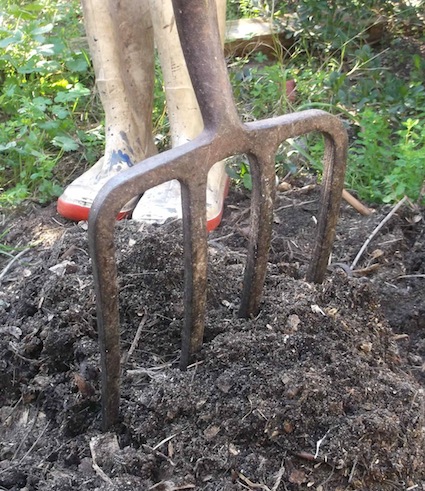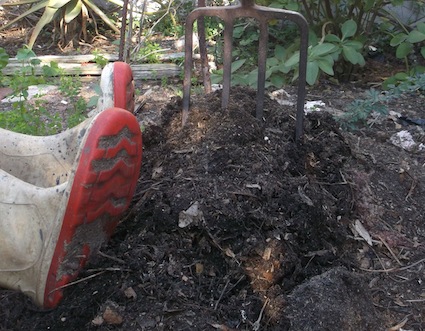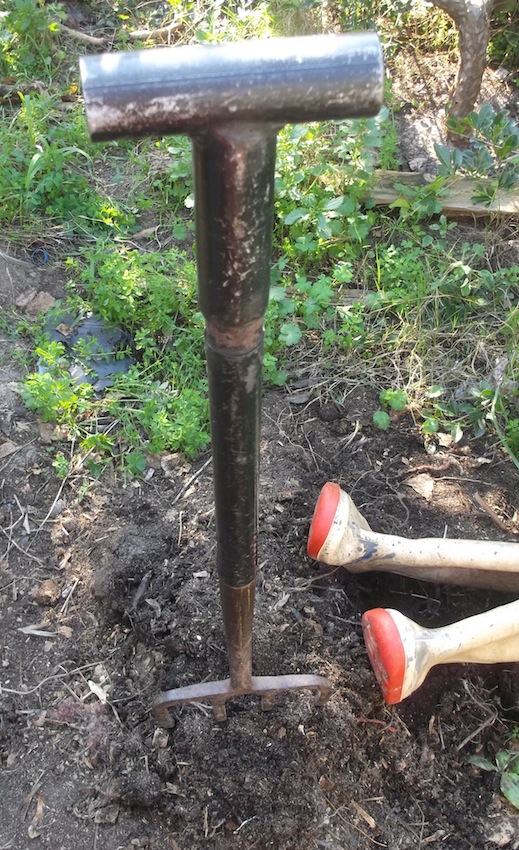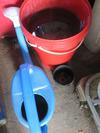Dear Reader, in this age of AI created content, please support with your goodwill someone who works harder to provide the human-made. Sign up at the top of the lefthand column or bottom of this page. You will receive my hand illustrated monthly newsletter RESTORE NATURE and access to the biodiversity garden design course as I write...and nothing else, I respect your time. I am also removing the advertizing as best I can as its become intrusive inappropriate and pays me nothing.
the need for
aerobic composting
and how to do it

In the previous article on aerobic composting we covered some background information on plant nutrients and soil organisms. Here we will explain how it is done, based on the talk given by Marcé, a trained permaculturist.
Why the need for aerobic composting ?
Topsoil is being lost globally. So for remedial action fast
composting would be ideal. Cold composting used in the garden when a compost
pile is slowly added to, is a very slow process. Hot composting on the other
hand is extremely fast. The heat also kills pathogens and seeds, keeping the
weeds down where it is used. It may have further implications for the management of human waste, as the first article reveals.
how to keep it hot
According to Marcé, to maintain a temperature of 25-65 degrees, the C:N
(Carbon:Nitrogen) ratio
must be about 25-30:1. The heap will reach around 65 degrees on about days 6-8, if you've got this right and will maintain a slightly lower heat once you start turning every 2nd day. The previous article explains what C, N and other
elements are. N can be found in wet ingredients, C in dry grass and
dry garden refuse like brown leaves. Thus roughly, build the
compost heap with 1 green bucket green to 2 brown. Very large material must be made small, with a shredder or by hand. Place sticks in the bottom layer to keep the bottom drained, and aerate. Pile it up to make a heap of about 1.5 meters. It has to be this big to maintain the internal heat. Start with a compost activator, if you wish. Urine is a good activator. After making the heap, every second day turn the outside of the heap inside. Good hot compost with the right C:N ratio doesn’t shrink a lot, and if it does it means there is too much N. To remedy add an ingredient like sawdust which is high in C when you fork over the heap.

turning the heap made frightfully easy
Stir the heap after two days. To do this, and make sure all material gets similar heat exposure, work around the heap with a pitch fork and remove the outer layer, and pile it in a heap. Use this as the core of the second heap you’re building, work inwards on the old heap, layering the centre of the old heap on the outside of the second, new heap.
The right moisture content is also important. You have placed sticks at the bottom to ensure good drainage. To test the heap’s moisture, squeeze a lump of it in your hand. You must get only one drop or it is too wet and needs a central air-hole. If it is hot enough you can’t put your hand into the core. Check the moisture and temperature all the time for 6 days. White mold everywhere means it is too hot. If it is stinking, add sawdust or some material that is high in C. from day 10 – 18 just keep turning. You can google hot compost for more information.
There are three composting methods, vermicomosting, hot or aerobic composting and anaerobic composting for example Bokashi. You can see the info-graphic on the TUFCO page. Decomposition is very acidic in the beginning, and burns the roots of plants. So you can’t put raw compost on plants. Bokashi should also age for four weeks before you plant.
This sums up what I learned from Marcé, and it has introduced some fascinating questions and perspectives into my thinking on composting.

------
home page for more useful informationon eco friendly gardening
------
vegetable gardening the natural low cost way
------
gardening and where it all began
------
the other page on hot composting, nutrients and so on
------
easy composting: anaerobic composting
------
DIY rich organic garden fertilizer
You’re a home gardener ! Share your experiences and questions !
We all know about home gardening. Tell us about your successes, challenges and ask about issues that bother you. You may have the luxury of a back garden, but there are other ways we learn. Few people age without growing something or buying vegetables during their lives ! It is absolutely guaranteed that you have learned things which can help others on their gardening journey.
We invite you to share your stories, ask questions, because if a thing has bothered you it will bother others too. Someone may have a solution ! No question is too small. There is learning for everyone involved, for you, for me (yes, I learn from every question), for us all. Exciting stuff !
We are starting on a new journey. Every week we will profile your letters ! The best stories and questions we receive.
What Other Visitors Have Said
Click below to see contributions from other visitors to this page...
recycling waste for compost materials 




I heat up the pile by adding some well matured urine from the red bucket kept in the garage. To inoculate it with the right bacteria I add several litres …
Restore Nature Newsletter
I've been writing for four years now and I would love to hear from you
Please let me know if you have any questions, comments or stories to share on gardening, permaculture, regenerative agriculture, food forests, natural gardening, do nothing gardening, observations about pests and diseases, foraging, dealing with and using weeds constructively, composting and going offgrid.
SEARCH
Order the Kindle E-book for the SPECIAL PRICE of only
Prices valid till 30.09.2023
Recent Articles
-
garden for life is a blog about saving the earth one garden at a time
Apr 18, 25 01:18 PM
The garden for life blog has short articles on gardening for biodiversity with native plants and regenerating soil for climate amelioration and nutritious food -
Cape Flats Sand Fynbos, Cape Town's most endangered native vegetation!
Apr 18, 25 10:36 AM
Cape Flats Sand Fynbos, a vegetation type found in the super diverse Cape Fynbos region is threatened by Cape Town's urban development and invasive alien plants -
Geography Research Task
Jan 31, 25 11:37 PM
To whom it may concern My name is Tanyaradzwa Madziwa and I am a matric student at Springfield Convent School. As part of our geography syllabus for this
"How to start a profitable worm business on a shoestring budget
Order a printed copy from "Amazon" at the SPECIAL PRICE of only
or a digital version from the "Kindle" store at the SPECIAL PRICE of only
Prices valid till 30.09.2023








